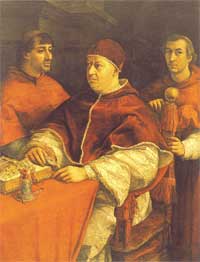Raphael Biography - Rome
In 1508, the great Pope Julius called Raphael to his service in Rome. Under the benevolence of his new patron, Raphael's art developed in every direction, and he begins the great wall paintings of the Vatican which are the full bloom of decorative art. His frescoes are decorating the Vatican chambers, and the chamber known as Stanza della Segnatura is displaying two of his masterpieces: Disputa and The School of Athens.

Raphael:
Pope Leo X. with two Cardinals
Uffizi, Florence
He paints also portraits which remain as surely among the most prodigious representations of realistic study. Even in the few painted in Florence we feel the uncompromising perception of the individual. Their methods may be undeveloped, but are faithful to the essential difference of the portrait as having its own mode of life. They are few in number, but they testify to a prodigious sincerity and a power of suggesting some intimate life behind that of the external one. The means by which he attains this are as mysterious as the causes of the grace and nobility of his great show pieces.
The next Pope, Leo X, was less great than his predecessor, certainly less noble, but more distinctly fond of the pleasures of art. That charm which satisfied the sterner Pope was more than sufficient to make the self-indulgent Medicean favor Raphael and his cohort of friends and dependants, just as the independent standing of Michelangelo displeased him.
Between 1513-1514, Raphael painted the Sistine Madonna. In 1514, he accepted the position of Architect of the new Saint Peter's, obtaining, with his usual good fortune, the help of a learned assistant who could be at the same time his teacher, the celebrated Dominican Fra Giocondo of Verona, and was having translated for him Vitruvius, in whose pages the men of that day hoped to find the secret of all ancient architectural art.
In the same year, in one of his few letters to his uncle, the brother of his mother, at home in Urbino, he tells how he was staying at Rome, "as he shall never be able to stay anywhere else again, out of love of the building of Saint Peter's. For what spot on earth is more dignified than Rome? What enterprise is more dignified than St. Peter's - the first temple of the world and the greatest piece of building that has ever been seen?" He tells his uncle how well satisfied he is, "how he holds property in Rome, and an income, and a salary from St. Peter, never to fail so long as he lives, and that he has more work for very large sums; and finally that Cardinal Bibbiena, his friend and patron, wishes him to marry a niece, and that he is engaged to her, and therefore that he is doing credit to his family, and to the lords of his native Urbino, to whom he sends homage."
Great moneyed men were now in the front, and in a day which pre-eminently recognized achievement in every direction it seemed but fitting that their position should receive the adornment of cultured art.
Naturally, again the name of Raphael becomes associated with that of the great banker Chigi, and, for him and for others, adorns or presides over the decorations of palaces. What we today call the Villa Farnesina is another of the buildings which Raphael marks with his name. Most of what we see is not his own handwork. No mere man could have carried this out with the very many other decorations and special paintings he had undertaken. So that these buildings are translated into the language of his assistants; even then they seem fine dreams of that classical antiquity which was beginning to be dug out from the ruins of Rome.
More on Raphael Sanzio's life: